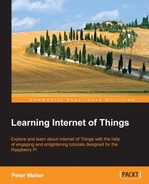Like with the sensor and the actuator, we need a CoAP endpoint in our controller to be able to communicate over CoAP:
private static void MonitorCoap()
{
CoapEndpoint Endpoint = new CoapEndpoint();We want to monitor two of our observable resources: the light sensor and the motion detector on our sensor. The simplest way to do this is to use the CoapObserver class, as shown in the next code snippet. This class performs the corresponding event subscription call to the resource and makes sure the values are constantly being reported, as expected. If no values are received within a given time frame, it will issue new event subscription calls. In this way, the observer recovers messages if they are lost or the observed resource is restarted:
CoapObserver LightObserver = new CoapObserver (Endpoint, true,"192.168.0.15", CoapEndpoint.DefaultCoapPort, "light/txt",string.Empty, 2 * 5); CoapObserver MotionObserver = new CoapObserver (Endpoint, true, "192.168.0.15", CoapEndpoint.DefaultCoapPort, "motion/txt", string.Empty, 10 * 5);
The first parameter in the constructor refers to the CoAP endpoint that is responsible for the communication. The second Boolean parameter tells the observer whether confirmable or nonconfirmable messages are to be used. Confirmable messages require acknowledgment messages to be sent when received, which permits the sender to use a retry mechanism to make an attempt to ensure the message is delivered even in cases when messages are dropped for various reasons.
The third parameter is the IP address or the hostname of the machine hosting the observable resource. The fourth parameter is the corresponding CoAP port that is used. Following these parameters is the name of the resource. This is followed by any query parameters (none in our case) and eventually an acceptable number of seconds before new subscription requests could be sent, unless notifications are received within this time frame. As a window, we use five times the maximum age for our resources for when should the notifications be received or new subscription requests sent.
There are two events in the observer class: OnDataReceived is raised when a new notification is received and OnError when an error message or timeout event occurs. These two events can be used to control the behavior of our application. We begin by declaring two local variables:
bool HasLightValue = false; bool HasMotionValue = false;
We use the OnDataReceived event to react to incoming light density notifications, as follows:
LightObserver.OnDataReceived += (o, e) =>
{The notification payload from the resource will be a string, and it is available in the Response property. We examine it and see whether it has the correct format and whether we can extract the numerical value from it:
string s = e.Response as string;
double d;
if(!string.IsNullOrEmpty(s) && s.EndsWith(" %") && XmlUtilities.TryParseDouble(s.Substring(0, s.Length - 2), out d))
{If we can do this, we store it in our control variables:
lightPercent = d;
if(!HasLightValue)
{
HasLightValue = true;
if(HasMotionValue)
hasValues = true;
}Having done this, we call the CheckControlRules method defined earlier. This method will look for the available values and signal appropriate actions:
CheckControlRules(); } };
We implement the reception of motion notifications in a similar manner.
The last thing we need to do is perform the actual control actions by calling the resources defined in the actuator. Control actions in our application are flagged through event objects that the controller monitors. Instead of calling an HTTP resource, as we did previously to set the LEDs of the actuator corresponding to the value of the light sensor reports, we send a confirmable POST message using CoAP. Here, the variable i contains a value between 0 and 255 representing the state of each LED:
Endpoint.StartPOST(true, "192.168.0.23", CoapEndpoint.DefaultCoapPort, "do/txt", string.Empty, i.ToString(), CoapBlockSize.BlockLimit_64Bytes, null, null);
We use the asynchronous StartPOST() method instead of the synchronous POST() method since for our purposes, it is sufficient to start sending the command. Since we use the confirmable message service (the first parameter), the CoAP endpoint will perform retries if no acknowledgement is received from the actuator. The second and third parameters define the name or IP address of the host machine hosting the resource, together with the port number to use. The fourth parameter corresponds to the actual resource, and the fifth to any query parameters (none in our case). The sixth parameter contains the actual payload of the message, which in our case is simply the byte value that corresponds to the digital output states. After the payload, we define a maximum block size for the delivery of the message. Finally, a callback method is sent to call when the message has been sent or failed, and a state parameter is sent to the callback method. In our example, we don't need to worry about the success or failure of the message; so we leave these as null. Sending the command to control the alarm output is done in a similar manner.
We are now done with the CoAP implementation in the sensor, actuator, and controller applications. To access the complete source code, please download the example projects.
Tip
You are encouraged to compare the communication between the sensor, controller, and actuator using line listeners, WireShark, or other sniffing tools. You should do this using the HTTP versions from the previous chapter first and then the CoAP versions from this chapter. This will enable you to see the real differences between HTTP and CoAP and be able to compare telegram sizes and so on.
